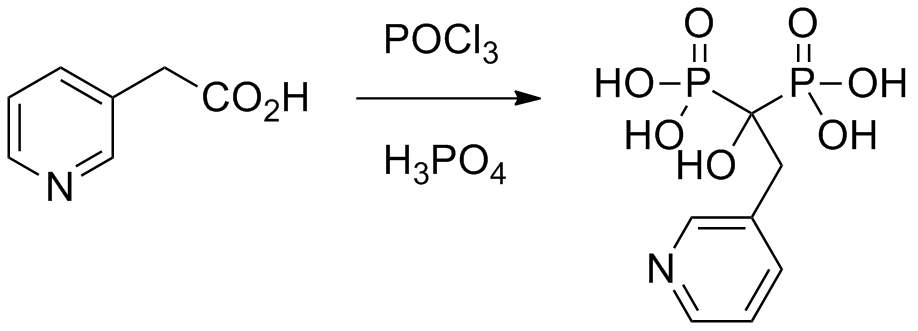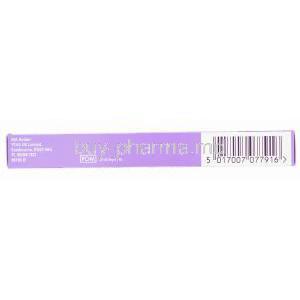Risedronate
- I. Introduction
- II. Uses
- III. How it Works
- IV. Off-label Use
- V. Dosage and Administration
- VI. Composition
- VII. Common Side Effects
- VIII. Interactions
- IX. Warning and Contraindication
- X. Careful Administration and Important Precautions
- XI. Special Population Administration
- XII. Over Dosage
- XIII. Storage
- XIV. Handling Precautions
I. Introduction
Risedronate holds a place in the records of medical history due to its historical development and approval. Originating in the 20th century, this medication emerged as a notable example, among anti-resorptive agents. As a member of the bisphosphonate class, Risedronate marked a milestone in the field of bone health. These compounds, bisphosphonates, work by attaching to areas where bone resorption occurs, regulating osteoclastic activity and ultimately assisting in preventing bone loss.
II. Uses
Risedronate offers a range of therapeutic benefits. Its primary purpose is to prevent and treat osteoporosis in women after menopause. During this phase, bone resorption increases, making fractures more likely. Risedronate plays a role in stopping this accelerated bone degradation and helps strengthen the bones. In the case of Paget's disease of bone, which involves bone remodeling, Risedronate has shown significant improvement by reducing osteoclastic hyperactivity and restoring skeletal balance. When treating induced osteoporosis, a side effect of long-term glucocorticoid therapy used for inflammation and immune suppression, Risedronate effectively counteracts the negative impact on bones.
References: 1 Risedronate: 7 things you should know - Drugs.com 2 Actonel (risedronate): Osteoporosis Medication Side Effects & Dosage 3 Prevention and treatment of glucocorticoid-induced osteoporosis
III. How it Works
Understanding how Risedronate works provides insights into the complex dance of bone dynamics. Essentially this medication targets the process of bone breakdown by blocking the activity of osteoclasts responsible for degrading bone. By calming down these osteoclasts, the balance shifts towards building up bone. Additionally, Risedronate has an impact on bone mineral density (BMD). Increased BMD not indicates stronger bones but also reduces the risk of fractures. By improving BMD, Risedronate promotes skeletal strength and resilience.
IV. Off-label Use
While the primary uses of Risedronate are well-defined, there are also off-label applications worth exploring. One notable example is its potential to manage hypercalcemia. Risedronate can help restore balance during hypercalcemic crises by regulating calcium release from bones. Another important use is in treating bone metastases associated with types of cancer, particularly breast or prostate cancers. These malignancies can sometimes spread to the system resulting in metastatic lesions. Risedronates' ability to inhibit bone resorption slows down the progression of these metastatic foci. Looking ahead, future applications for Risedronate are currently being studied. Early research suggests its effectiveness in conditions such as osteogenesis imperfecta and specific arthritic disorders which could open new avenues for clinical treatment.
References: 1 Treatment of hypercalcemia - UpToDate 2 Risedronate: 7 things you should know - Drugs.com 3 Risedronate in adults with osteogenesis imperfecta type I: increased bone mineral density and decreased fracture rate - Springer
V. Dosage and Administration
The effectiveness of a drug dramatically depends on how it's administered. When it comes to Risedronate, paying attention to the dosage and how it should be taken is essential. Here are some recommended dosages for conditions; For postmenopausal osteoporosis, the usual dose is around 5 mg per day, while Paget's disease may require an increase to 30 mg per day for a shorter period, usually about two months. Timing and method of administration are factors. Taking Risedronate in the morning as a tablet with plenty of water 30 minutes before breakfast is essential. The duration of treatment should also be considered. Chronic conditions like osteoporosis often require long-term therapy that can last for years. On the hand, temporary ailments may only need short treatment courses.
VI. Composition
When we delve into the composition of Risedronate, we discover a mixture of ingredients, each playing a role in its pharmacodynamic effects. The active ingredient, Risedronate sodium, is the formulation's element and works diligently to inhibit bone resorption. In addition to the ingredient, some inactive ingredients and excipients contribute to the tablet's structure and help it break down after being taken. These components often include microcrystalline cellulose or magnesium stearate. Risedronate is primarily available in tablet form, but variations, such as immediate or delayed release, may vary depending on specific clinical needs.

VII. Common Side Effects
Risedronate can have side effects like any medication, some familiar and others more uncommon. Gastrointestinal issues may occur, such as nausea or heartburn. These symptoms are usually temporary. It can be managed with dietary changes or additional medications if necessary. Sometimes there might be discomfort, especially in the lower back area. If this happens, it may require pain relief measures. Although rare, there are side effects to be aware of. Osteonecrosis of the jaw is an uncommon complication requiring immediate medication discontinuation and a thorough dental evaluation.
VIII. Interactions
The field of pharmacology related to Risedronate is full of interactions. It's essential to be aware of these interactions to use this medication for its benefits effectively. Some drugs can affect the absorption of Risedronate. For example, when taken at the time, antacids or calcium supplements can reduce the absorption of Risedronate, which may diminish its effectiveness in treating medical conditions. Additionally, some medications can increase the risk of fractures when taken with Risedronate. Glucocorticoids are one type of medication that may require periodic assessments of bone mineral density due to their potential impact on fracture risk. It is also worth noting that certain foods, those rich in calcium, can interfere with the absorption of Risedronate. Therefore it is essential to follow a dietary regimen after taking this medication. Understanding and considering these factors will help maximize the benefits and minimize potential complications associated with using Risedronate.
IX. Warning and Contraindication
Medical treatments are precious. It's essential to be cautious and use discernment, mainly when contraindications occur. This is also true for Risedronate, which requires consideration before starting treatment. Patients with pre-existing conditions, such as esophageal issues, low calcium levels, or those who can't sit or stand upright for 30 minutes may not be suitable candidates for Risedronate administration. Additionally, patients with reactions or hypersensitivity to any ingredients in Risedronate should avoid this treatment option.
X. Careful Administration and Important Precautions
Risedronate, a medication known for its benefits, requires careful administration and adherence to precautions to achieve optimal therapeutic results. It is essential for individuals with kidney disorders to adjust the dosage based on the function to avoid excessive exposure and potential kidney-related issues. Regular monitoring, through check-ups and laboratory evaluations, can help proactively identify and address any possible adverse reactions. If a dose is missed, taking the scheduled amount, as usual, is advisable without doubling up on medication.
XI. Special Population Administration
The use of risedronate extends to a range of patients, each with its specific clinical challenges and factors to consider.
Administration to the Elderly
As people grow older, their body's ability to process medications can. They may become more sensitive to drug reactions. To ensure the effective use of medicines in older individuals, doctors often need to make adjustments to the dosage. These adjustments are usually made with caution taking into account the needs of each patient. It is also essential to monitor the bone density of individuals who are taking Risedronate as part of their treatment plan. Regular evaluations of bone mineral density can help optimize the effectiveness of this medication and ensure that therapeutic goals are being met.
Administration to Pregnant Women and Nursing Mothers
The phase of motherhood, with its physiological aspects, brings about unique challenges and factors to consider when it comes to medication. In terms of known risks and benefits, While the potential for Risedronate to cause birth defects is still uncertain, healthcare professionals cautiously approach its use during pregnancy unless the potential benefits outweigh the risks. Regarding recommendations during breastfeeding, Due to the information available on how Risedronate might be passed into human milk, it is advisable to make a thoughtful decision that often involves weighing whether to continue taking Risedronate or breastfeeding.
Administration to Children
When it comes to children, their changing physiology requires a different approach when administering Risedronate. We are still investigating the safety and effectiveness of Risedronate in children, so we don't have evidence yet. Since there aren't guidelines specifically for pediatric dosing, it's essential to take an individualized approach. We often base it on adult dosing. Make adjustments for weight and maturity.
XII. Over Dosage
In the world of pharmacotherapy, accidental overdoses are not uncommon. It is crucial to understand the consequences of an overdose of Risedronate and other medications to intervene promptly and effectively. Symptoms and presentation; If exposed to much Risedronate, they may experience hypocalcemia, characterized by numbness around the mouth, muscle spasms, and, in severe cases, difficulty breathing due to laryngeal stridor. Additionally, there could be irritation or ulcers in the esophagus that further complicate the situation. Management and treatment options; Seeking medical attention is necessary. Procedures like lavage or using activated charcoal might be considered if the ingestion occurred recently. Maintaining calcium levels through intravenous calcium gluconate is of utmost importance. Long-term consequences and follow-up care; It may be necessary to monitor for esophageal or gastric lesions through endoscopic surveillance. Periodic evaluations of calcium and phosphate levels could also play a role in ensuring overall physiological balance.

XIII. Storage
The effectiveness of Risedronate-like medications depends on how it is stored. To ensure that it remains safe and effective, keeping Risedronate in a dry place at room temperature, away from direct sunlight and moisture, is best. It's essential to consider the shelf life of Risedronate. After its expiration date, the medication may lose its benefits and become less effective or even harmful. When disposing of expired Risedronate tablets, it is recommended to take them to a designated pharmaceutical disposal site, throw them in the regular trash, or flush them down the toilet.
XIV. Handling Precautions
In the treatment field, it is crucial to handle medications with care. Regarding Risedronate, some guidelines must be followed to ensure safety. To ensure the well-being of patients and caregivers, it is essential to wear gloves when handling this medication. Additionally, the tablets should not be. Split, and one should avoid direct contact with any broken tablets. If someone accidentally gets the drug on their skin, it is recommended to rinse the affected area with water. In case of ingestion, especially in situations involving children or other vulnerable individuals, immediate medical advice should be sought.























